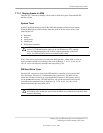
Chapter 7 BIOS ROM
7.7.3.2 Going to Sleep in APM
There are three levels of system sleep in APM: System/Hard Drive Standby, System
Suspend, and System Off.
System/Hard Drive Standby
System Standby is achieved only by a system timer time-out, at such time the following
occurs:
1. All APM-aware device drivers put their respective devices into “Device Standby.”
2. The O/S makes a BIOS call to go into System Standby.
NOTE: The BIOS ROM of these systems will not turn the fan(s) off as on
previous systems).
If the hard drive timer times out due to inactivity the hard drive motor stops spinning the
platters. Depending on drive type, some drives can cut power to some of the drive
electronics that are not needed during standby. The drive(s) can be in this state with the
system still awake. Since the hard drive timer is in the hard drive controller and triggered
by drive access, the system can be in Standby with the hard drive(s) still spinning
(awake).
System Suspend
System Suspend is invoked by pressing and releasing the power switch in under four
seconds (pressing and holding the switch longer that four seconds will turn the system
off).. The system does not time-out from Standby into Suspend.
Upon invoking Suspend, the following actions occur:
1. All APM-aware device drivers put their associated devices into “Device Standby.”
2. The O/S makes a BIOS call to go into Standby, and the BIOS:
a. Spins down the IDE drives
b. Halts the processor. The processor remains halted until the next 55ms tick from
the RTC.
c. At the 55ms tick of the RTC the processor executes a BIOS routine to check to
see if anything has happened to wake the system up. If not, the processor is
halted again.
d. Steps B and C are repeated until a wake-up event occurs.
NOTE: These systems will not turn the fan(s) off as in previous systems.
Compaq Evo and Workstation Personal Computers
Featuring the Intel Pentium 4 Processor
Second Edition - January 2003
7-22


















